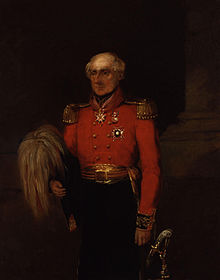Colin Campbell (British Army officer, born 1776)
|
Lieutenant General Sir Colin Campbell KCB |
|
|---|---|

Sir Colin Campbell by William Salter
|
|
| 8th Governor of British Ceylon | |
|
In office 15 April 1841 – 19 April 1847 |
|
| Preceded by | James Alexander Stewart-Mackenzie |
| Succeeded by |
James Emerson Tennent acting governor |
| 17th General Officer Commanding, Ceylon | |
|
In office 16 April 1841 – 28 January 1847 |
|
| Preceded by | Robert Arbuthnot |
| Succeeded by | William Smelt |
| 25th Lieutenant-Governor of Nova Scotia | |
|
In office 1834–1840 |
|
| Preceded by |
Thomas Nickleson Jeffery acting |
| Succeeded by | The Viscount Falkland |
| Military service | |
| Allegiance | United Kingdom |
| Service/branch | British Army |
| Rank | Lieutenant general |
| Unit | 78th (Highlanders) Regiment of Foot |
| Commands | General Officer Commanding, Ceylon |
Lieutenant-General Sir Colin Campbell KCB (1776 – 13 June 1847) was a British Army officer and colonial governor.
Campbell was the fifth son of Colonel John Campbell of Melfort, and Colina, daughter of John Campbell of Achalader. From his boyhood Campbell gave evidence of a daring disposition, and in 1792, at the age of sixteen, he ran away from the Perth Academy, and entered himself on a ship bound for the West Indies. He was met in the fruit market at Kingston in Jamaica by his brother (afterwards Admiral Sir) Patrick Campbell, then serving on HMS Blonde, who brought him home. His parents yielded to his wishes, and in 1793 he became a midshipman on board an East Indiaman and made one or two voyages.
In February 1795 Campbell became a lieutenant in the 3rd battalion of the Breadalbane Fencibles, then commanded by his uncle, Lieutenant Colonel John Campbell of Achalader. With the Fencibles he saw action in the Irish Rebellion of 1798. On 3 October 1799 he entered a West India regiment as ensign, and in 1800 acted as brigade-major in the island of St. Vincent. On 21 August 1801 he was gazetted a lieutenant in the 35th Foot, and at once exchanged into the 78th Foot (Ross-shire Buffs), which was then stationed in British India. He joined his new regiment at Poona, accompanied Arthur Wellesley in the Second Anglo-Maratha War against the Maharajah Scindia and the Rajah of Nagpore, and so greatly distinguished himself by leading the flank companies at the storming of the Pettah of Ahmednagar on 8 August 1803 that Wellesley at once appointed him brigade-major. In this capacity he served at the Battle of Assaye, where he was severely wounded and had two (or possibly three) horses killed under him, at the Battle of Argaum, and at the storming of Gawilghur.
...
Wikipedia
